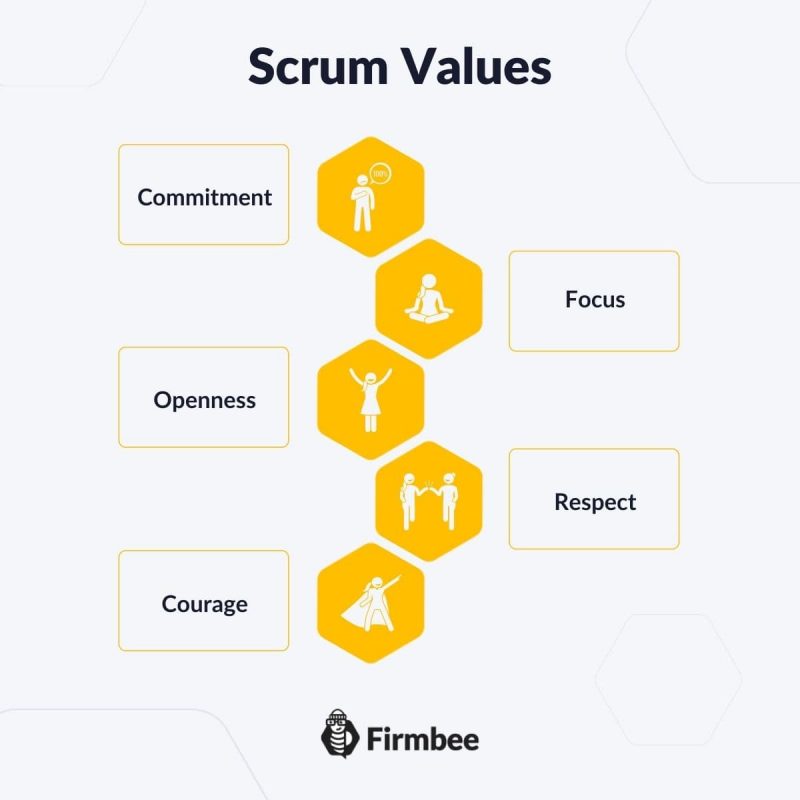Scrum is a method aimed at optimizing teamwork. It not only answers the question of how to organize the work of Scrum Team members but also defines how they should approach the work and each other. The guidelines and details of the latter have been described as Scrum values and today’s article is going to focus exactly on that matter.
5 key scrum values – table os contents:

Scrum Values
Now, when we are acquainted with basic Scrum terms and we know what the Scrum method is, we can move forward and learn something about Scrum values. Scrum values were not always present in the official Scrum Guide. They were added by user request to the edition published in 2016. In today’s article, we will describe the Scrum values one by one, namely:
- Commitment
- Focus
- Openness
- Respect
- Courage
The update of the Scrum Guide followed the principle of empiricism. That is, it was done based on the experiences of the teams implementing Scrum. It turned out that even the strict observance of the Scrum workflow didn’t always cause positive changes in the teams. The purpose of introducing the Scrum values was to clearly define the right approach to foster the implementation of Scrum principles.
Commitment
The first value that underpins the proper implementation of Scrum is the commitment to the work. A Scrum-oriented development team has to be committed to Sprint Goal and Product Goal.
But even more important is the commitment of each individual Developer. It provides not only an active effort to solve problems that arise in the course of daily duties. It also includes the willingness to support other members of the Development Team when they need it.
Focus
If each of the Developers is focused on sub-tasks with full commitment, it can be easy to lose sight of the main Product Goal and even the Sprint Goal, which we write about in detail here. As a result, the Increment produced in a given Sprint will turn out to be incomplete. Therefore, focusing on Sprint Goal is extremely essential from a team perspective.
Focus improves not only the level of tasks performed by individual Developers but also, their results come together to achieve Sprint Goal. And thus, the business value is realized: Scrum Team’s workflow enables the creation and development of Product functionality.

Openness
The agile approach differs from the traditional approach primarily in its openness to change. That is why it was among the main values of Scrum. Both the Scrum Team and the Stakeholders benefit by cultivating the value of openness in their work.
The variability in question can refer to many areas of the project, for example:
- reduction of the project scope
- redefinition of Product functionality
- reorganization of tasks performed by Scrum Team to optimize efficiency
Changes can result from Stakeholder decisions, business or technical constraints. Openness in the face of change is supported by transparency, which is one of the pillars of empiricism in Scrum. Thanks to transparency, Scrum Team members and Stakeholders know what the change results from and where it can lead.
Respect
Scrum Team members are independent, equal individuals. Developers, Scrum Master and Product Owner are all professionals who treat each other with due respect. There should be no room for hierarchy in a Scrum Team.
Respect also serves to provide psychological well-being. This is especially true for members of the Development Team. By showing respect to each other, they can experiment freely and not be afraid to make mistakes, which are a necessary part of the innovation process and lead to improved Scrum Team performance.
Courage
Courage in problem-solving is, along with respect, a prerequisite for successful experimentation. It also makes the Scrum Team, when faced with difficult tasks, repeat attempts to solve them, until obtaining a satisfactory result.
Being courageous in proposing business, technical, and interpersonal solutions helps to realize the innovation potential inherent in Scrum. Courage is also the foundation of self-management of the Scrum Team, which takes full responsibility for the consequences of the decisions made by the team members.
Scrum Values – summary
At the core of Scrum are five values: courage, respect, openness, focus, and commitment. They all define important areas of approach to teamwork. But it is equally essential that they are present in the individual mindsets of the Scrum Team members. Nurturing the Scrum values contributes to optimizing teamwork and improving team members’ satisfaction from their tasks.
If you like our content, join our busy bees community on Facebook,Twitter and Linkedin.
Author: Caroline Becker
As a Project Manager, Caroline is an expert in finding new methods to design the best workflows and optimize processes. Her organizational skills and ability to work under time pressure make her the best person to turn complicated projects into reality.
Scrum Guide:
- Glossary of basic terms, roles and notions
- What is Scrum?
- Scrum values
- How to implement Scrum in your company?
- Scrum Team - what is it and how does it work?
- Who is a Product Owner?
- The most common mistakes of Product Owner
- Who is the Scrum Master?
- Characteristics of a good Scrum Master
- The most common mistakes of Scrum Master
- What statistics and metrics should the Scrum Master track?
- Cooperation between Product Owner and Scrum Master
- Development Team in Scrum
- The most common mistakes of Developers
- Scrum artifacts
- Scaling Scrum
- Sprint Backlog
- What is the Product Backlog?
- What are User Stories?
- Creating the best User Story with INVEST
- The most common User Story mistakes
- User Story Acceptance Criteria
- Estimation and Story Points in Scrum
- Planning Poker
- Team Estimation Game
- Defining Increment
- Scrum events
- What is Sprint in Scrum?
- Scrum Team Commitments - Product Goal, Sprint Goal and Definition of Completion
- What is a Burndown Chart?
- How to create and interpret a burndown chart?
- Advantages and disadvantages of the burndown chart
- Kanban boards in Scrum and Scrumban
- Velocity in Scrum - Speed of the Development Team
- Daily Scrum
- Sprint Planning
- Sprint Review
- What is a Sprint Retrospective?
- Common mistakes during a Sprint Retrospective
- Product Backlog nurturing


















